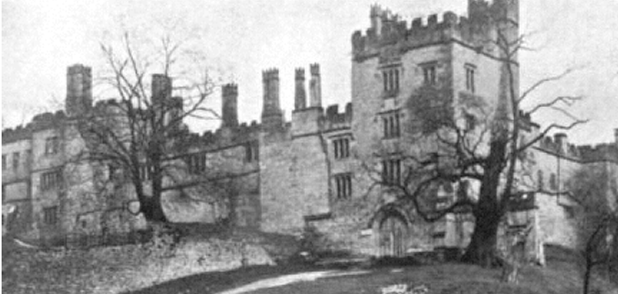Dorothy Vernon of Haddon Hall
This is the story of the creation and development of the legend of Dorothy Vernon. According to tradition Dorothy eloped with John Manners from her home at Haddon Hall and from her father the 'King of the Peak.' This is an original effort researched and written by the editor of this web site.
The elopement is appropriately called a legend. But 'legend' may be defined in two ways: a popular myth or a story regarded as true although not entirely verifiable. That the imperious George Vernon lived and ruled Haddon with its surroundings, that Dorothy and John were married and inherited Sir George's lands, there can be no doubt. However there are no surviving household accounts of pre-nuptial meetings to indicate a planned marriage. Nor are there church records to indicate a runaway wedding performed at a distance from Haddon. 'Legend' as used within these pages may be interpreted, according to the inclination of the reader, to fall within either definition or as the author has found, to denote a shifting state of conviction as historical claims are seized upon or discounted.
There has claimed to be an 'oral tradition' telling the tale of a runaway Vernon - Manners marriage. Unfortunately, no one has transcribed such a story without embellishment and the introduction of obvious artifices. It would be expected that the legend would have found its way into one of the many Derbyshire ballads which have been transcribed, but this is not so. The content of the tale of oral tradition has been lost. One suspects that the oral versions of the tale were vague and imprecise as Allan Cunningham's 'Rhyme of Dora Vernon (p22) and that much was read into them after visits to Haddon Hall and Bakewell Church (where the Vernon and Manners are entombed). However, as in most aspects of the romantic legend, each reader will arrive at his or her own conclusion.
George Vernon, the King of the Peak, held sway over the Haddon lands and their wealth from about 1529, when he became of age, until his death in 1565. It was near the end of this period that his daughters Margaret and Dorothy were married. For the next two hundred plus years, Dorothy became known as the coheiress who brought Haddon Hall and its lands to the Manners family. There was never a reference to a marriage under exceptional circumstances.
The foundation for the legend was formed in the period approximately from 1790 into the 1820s. The Manners family had quitted Haddon Hall and it lay empty and sparsely furnished. The only residents were the caretaker and his wife, who resided outside the walls in a cottage down the hill from the northwest entrance. Visitors were allowed inside the walls and the caretakers conducted personal tours of the entire castellated mansion. Many sightseers were taken by the medieval atmosphere and perceived similarity to the desolate settings of contemporary gothic novels. Newly written guide books would assert that novelists received inspiration and even wrote large portions of books within the Haddon walls. Thus began the interweaving of Haddon Hall's history with the pages of the novel.
The creation of the legend took place over a short two year span in the early 1820s. By creation is meant bringing to light a two hundred year old Derbyshire tale or alternately manufacturing an elopement out of whole cloth. The story is the same in either instance, and by the end of the century became recognized as one of the renowned courtships of England. The Vernon - Manners romance was told by two authors within two separate works, both coincidentally entitled 'The King of the Peak.' The tales were told from the viewpoint of Sir George Vernon and the world within Haddon Hall. Dorothy Vernon would not take the title of the story for almost forty years.
The legend was nurtured and grew over the next thirty years. No new fictional works were produced in this period. Instead respected scholars and journalists visited Derbyshire and were guided around Haddon Hall. As part of their description of the structure and interior, they uniformly described a 'tradition' associated with Haddon. Thus did the elopement leap from the pages of fancy and conjecture into the pages of history.
In the future, nearly all factual accounts of Haddon Hall would include the elopement legend, whether by disparaging the tale or concurring in its truth. Novels built on the legend would maintain the historical personae of Haddon Hall, Sir George, Dorothy and John; the stories would differ in the paths taken to the same romantic ending.
The legend became fully developed and reached its final form in the fifty years between 1860 and 1910. A short story 'The Love Steps of Dorothy Vernon' was widely published in 1860. It was the first story to place Dorothy as the central character within Haddon Hall and its details defined what became to be regarded as the standard form of the legend. Historical inaccuracies contained therein could be attributed to a lack of knowledge concerning the particulars of Haddon and its inhabitants. These would be discovered in later years; but the tale continued to follow 'The Love Steps of Dorothy Vernon' and those who believed in the romance shrugged off these concerns.
Stories and novels, an operetta and a play were written. Scholars unearthed specific dates to reflect when the weddings of Sir George's daughters really did occur and when the various architectural features of the Hall came into being. Fact and fancy were made available in abundance. But the legend of Dorothy Vernon remained unchanged into the twentieth century.
For the complete history of the elopement story of Dorothy Vernon: Click to download 1.9 MB PDF file Dorothy Vernon of Haddon Hall also known as Haddon Hall's Dorothy Vernon : DOWNLOAD
A printed copy of the book may be purchased at www.LULU.com/shop
Enter TRUTT in the Search Books box.
